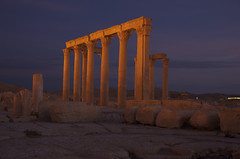About a year ago, an exciting opportunity came up at my job that I was nevertheless not quite sure about. It was an extension of what I was doing then (and am still doing now), but it meant a direction and an approach that I was not formally qualified for. I talked to my boss and we both agreed – at least that's how I remember it now – that it wouldn't be the right time for me to attempt this transition. A number of external candidates were interviewed and one of them took the job. I was enthusiastic to work with him and learn from a professional.
This professional is moving on now, and what was an exciting but rather distant and possibly missed opportunity less than a year ago is suddenly very hot. Recruitment is internal only, and the required skill set reads as if copied from my CV. My boss scheduled an unspecified "brief conversation" for tomorrow morning. Colleagues make allusions in the corridors. Is there something that I don't know?
With all this as a backdrop, I'm sitting on my sofa weighing the pros and cons. The main problem appears that I really like my job. It combines aspects of science with marketing into something that could be called science communication for commercial gain. I didn't think I'd enjoy this as much as I do.
More than two decades ago, I started training as a scientist. I proved my worth – or at least my persistence – by gaining a PhD in biochemistry. After that, I worked as a research scientist for exactly 10 years. The intellectual freedom, the collaborative approach and largely pleasant colleagues and bosses made this a difficult environment to break out from.
By one definition, I am not a scientist. Scientists are driven by burning curiosity and the need to answer obscure questions. They make personal and financial sacrifices because nothing is as important as the quest for knowledge. I was never such a person.
And yet, I'm a scientist according to my job title. I communicate and mingle with scientists all the time. I read scientific papers and submit abstracts to conferences - many more than when I was working in a lab. I'm also a better crystallographer now than when being good at it was a key to success. Now I travel around the world for talks and conversations, giving the impression of expertise and schmoozing the community. It's science a few steps removed.
Would doing less of it be so difficult, especially if it meant doing more of something else I like? Would the transition into full-time communication be in the least painful? Am I resisting change not to disturb my comfort? Or do I possibly fear the unknown more than I desire growth? How do I get out of my box?
The other day I finished Sheryl Sandberg's Lean in, my Christmas gift to Flucha though I was the one who read it. Promoting equality, the book contains lots of insights relevant to men as much as to women. Regarding career choices, the book speaks of jungle gyms instead of ladders. Ignore where what you've done is expected to take you. Look left and right to identify opportunities. If they present themselves, take them, even if you're not formally qualified. You will grow with every challenge and succeed with hard work. I think I'm on my way already.


